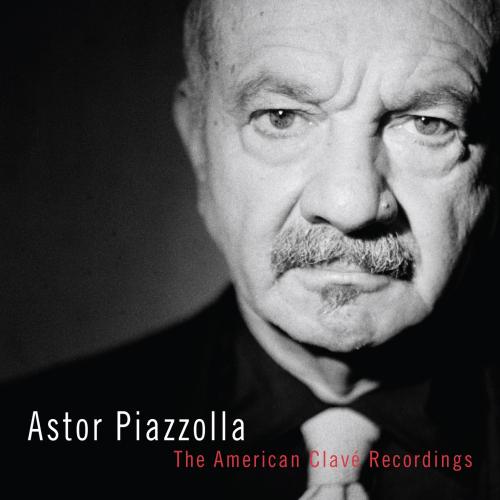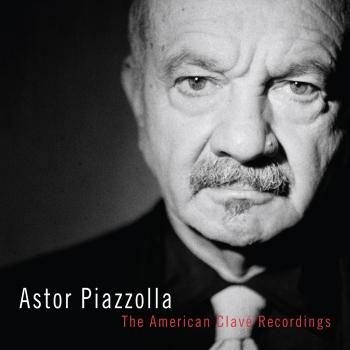
The American Clavé Recordings (Remastered) Astor Piazzolla
Album info
Album-Release:
2022
HRA-Release:
06.05.2022
Album including Album cover
I`m sorry!
Dear HIGHRESAUDIO Visitor,
due to territorial constraints and also different releases dates in each country you currently can`t purchase this album. We are updating our release dates twice a week. So, please feel free to check from time-to-time, if the album is available for your country.
We suggest, that you bookmark the album and use our Short List function.
Thank you for your understanding and patience.
Yours sincerely, HIGHRESAUDIO
- 1 Tanguedia III (2009 Remaster) 04:39
- 2 Milonga Del Angel (2009 Remaster) 06:31
- 3 Concierto Para Quinteto (2009 Remaster) 09:07
- 4 Milonga Loca (2009 Remaster) 03:11
- 5 Michelangelo '70 (2009 Remaster) 02:51
- 6 Contrabajísimo (2009 Remaster) 10:19
- 7 Mumuki (2009 Remaster) 09:37
- 8 Soledad (2009 Remaster) 07:52
- 9 La Camorra I (2009 Remaster) 09:27
- 10 La Camorra II (2009 Remaster) 07:03
- 11 La Camorra III (2009 Remaster) 11:07
- 12 Fugata (2009 Remaster) 03:11
- 13 Sur: Los Sueños (South: The Dreams) (2009 Remaster) 02:57
- 14 Sur: Regreso al Amor (South: A Return to Love) (2009 Remaster) 06:24
- 15 Prologue (Tango Apasionado) (2009 Remaster) 01:51
- 16 Milonga for Three (2009 Remaster) 06:00
- 17 Street Tango (2009 Remaster) 04:13
- 18 Milonga Picaresque (2009 Remaster) 01:35
- 19 Knife Fight (2009 Remaster) 01:50
- 20 Leonora's Song (2009 Remaster) 03:37
- 21 Prelude to the Cyclical Night, Pt. 1 (2009 Remaster) 00:50
- 22 Butcher's Death (2009 Remaster) 02:24
- 23 Leijia's Game (2009 Remaster) 02:24
- 24 Milonga for Three (Reprise) (2009 Remaster) 06:00
- 25 Bailongo (2009 Remaster) 01:46
- 26 Leonora's Love Theme (2009 Remaster) 03:53
- 27 Finale (Tango Apasionado) (2009 Remaster) 03:34
- 28 Prelude to the Cyclical Night, Pt. 2 (2009 Remaster) 00:55
Info for The American Clavé Recordings (Remastered)
Nonesuch Records will release a three-album-set of albums from the great Argentine composer, bandleader, and bandoneón player Astor Piazzolla—originally released by American Clavé Records in the 1980s and reissued by Nonesuch more than two decades ago. Astor Piazzolla: The American Clavé Recordings, marks the first time this landmark trio of albums—Tango: Zero Hour, La Camorra: The Solitude of Passionate Provocation, and The Rough Dancer and the Cyclical Night (Tango Apasionado)—is being issued as a set, now remastered, and is the first time the albums have been available on vinyl since their initial release on American Clavé. The set’s liner notes include original and new notes by the albums’ producer and American Clavé founder Kip Hanrahan as well as an in-depth essay from journalist Fernando González, who translated and annotated Piazzolla’s memoirs and wrote liner notes for four of his albums. Originally scheduled for release in Piazzolla’s centenary year 2021, the set now inaugurates the beginning of the second century of Piazzolla’s lasting influence.
González says in his 2021 note: “In May 1986, Astor Piazzolla, the creator of New Tango, entered the studio in Manhattan with his Quintet to record Zero Hour. It would turn out to be the first of three consequential recordings that would finally establish him in the United States and strengthen his standing around the world.”
Though Piazzolla was known as the progenitor of “nuevo tango,” Hanrahan says in his new liner note, “I’m not sure whether Astor really liked or loved or hated the tango. I think he loved the music his father surrounded the family with as the sound of what they’d left behind in Argentina … It was the audible identity that made them different from the Italian and Jewish families that lived around them on the Lower East Side of New York, where Astor grew up.
“When I listen to Astor, I’m not really listening to the tango re-imagined and saved by a brilliant composer, I’m listening to the music of a turbulent, complex, restless, brilliant man rearranging the vocabulary of his father’s dreams.”
Tango: Zero Hour was recorded in New York with Piazzolla and his classic New Tango Quintet, which worked with Piazzolla from 1978 to 1988 and included Fernando Suárez Paz (violin), Pablo Ziegler (piano), Horacio Malvicino, Sr. (guitar), and Héctor Console (bass). González says of Tango: Zero Hour: “These are demanding pieces, yet the individual playing remains consistently precise and intense throughout. As an ensemble, Piazzolla and his New Tango Quintet sound focused, loose and forceful. They are in total control of the music and prove it by casually changing direction, moods, and dynamics on a dime. Piazzolla immediately recognized that the quintet had accomplished something special, believing it to be ‘the greatest record I’ve made in my entire life. We gave our souls to [it].’” Tango Zero Hour was originally released by American Clavé in 1986.
First released in 1989, La Camorra was recorded in New York in May 1988, also with the New Tango Quintet. González writes: “La Camorra not only delivers a late masterpiece, the three-part title piece, but it also serves as a marker completing two significant chapters in Piazzolla’s life and musical career. Set up as three separate but related pieces, La Camorra is more than a summation. It suggests Piazzolla reflecting on tango, now lovingly, conjuring old players and styles, now angrily fighting with tango history, demanding his place in it.
“In Zero Hour style, Piazzolla completes the program with versions of pieces he had already recorded, polished to a gleam. The Quintet is again in excellent form. Featuring a substantial new work and impeccable performances of four repertoire pieces, La Camorra is a high water mark in Piazzolla’s discography. It was also Piazzolla’s last recording with the New Tango Quintet.”
The Rough Dancer and the Cyclical Night, also originally released in 1989, was recorded in New York in September 1987, with an ensemble that included Fernando Suárez Paz (violin), Pablo Zinger (piano), Paquito D’Rivera (alto sax, clarinet), Andy González (bass), and Rodolfo Alchourrón (electric guitar).
González says, “The Rough Dancer and the Cyclical Night (Tango Apasionado), recorded by Piazzolla without the Quintet, occupies a unique place in his discography. It is based on the music Piazzolla composed for Tango Apasionado, a dance and theater piece created by Graciela Daniele based on stories by Argentine short-story writer, poet, and essayist Jorge Luis Borges. But what truly sets The Rough Dancer apart in Piazzolla’s discography is how it was created. Up to this point, the studio for Piazzolla had been, for the most part, a means to document the music he was producing. But [at this point], Piazzolla was intrigued by the idea of using the studio as a creative tool, perhaps even for composing and arranging.”
Astor Piazzolla’s nuevo tango, which incorporates classical forms and jazz elements into the traditional tango, was so controversial at its advent that Piazzolla had his life threatened on numerous occasions and was even exiled from his country. The traditional tango, born out of the bordellos of Buenos Aires in the way that jazz began in New Orleans, had been haunted by its origins for decades. Piazzolla, with his innovative style and desire to legitimize the tango and bring it to a serious musical audience, changed the face of the music forever.
When Tango: Zero Hour was first released, Piazzolla was at the peak of his powers. The Village Voice called Piazzolla “a modern master” while the New York Times said, “To hear Mr. Piazzolla’s tangos as musical marvels is beside the point. As edgy lines and long-breathed tunes defy and embrace one another, the tangos suggest that even in the modern world, romance survives.”
Nonesuch’s Piazzolla catalog features a number of other significant recordings, including Piazzolla’s Concierto para bandoneón and Tres tangos, released in 1988, and his last recording, Five Tango Sensations, which was commissioned by the Kronos Quartet and released in 1991. In addition, Piazzolla’s first composition for Kronos, Four, For Tango, appears on their 1988 release Winter Was Hard. The music of Piazzolla is also featured on three Nonesuch recordings by the violinist Gidon Kremer: Hommage à Piazzolla, El Tango, Eight Seasons, and Tracing Astor; these also were released as a box set, entitled Hommage à Piazzolla: The Complete Astor Piazzolla Recordings.
Astor Piazzolla, bandoneon
Pablo Ziegler, piano
Fernando Suarez Paz, violin
Paquito D'Rivera, alto saxophone
Horacio Malvicino, Sr., guitar
Rodolfo Alchourron, guitar
Héctor Console, bass
New Tango Quartet
Originally produced by Kip Hanrahan and Astor Piazzolla.
Digitally remastered
Astor Piazzolla
was an Argentine tango composer and bandoneón player. His oeuvre revolutionized the traditional tango into a new style termed nuevo tango, incorporating elements from jazz and classical music. An excellent bandoneonist, he regularly performed his own compositions with different ensembles. He is known in his native land as “El Gran Astor” (“The Great Astor”).
Born in Argentina in 1921 to immigrant Italian parents, Piazzolla spent most of his childhood with his family in New York City. While there, he acquired fluency in four languages: Spanish, English, French, and Italian. He also started playing the bandoneon, quickly rising to the status of child prodigy. He returned to Argentina in 1937, where strictly traditional tango still reigned, and played in night clubs with a series of groups. The pianist Arthur Rubinstein (then living in Buenos Aires) advised him to study with the Argentine composer Alberto Ginastera. Delving into scores of Stravinsky, Bartók, Ravel, and others, he gave up tango temporarily and worked as a modernist classical composer.
After winning a grant from the French government to study in Paris with the French composer and conductor Nadia Boulanger, he returned to Argentina in 1955, formed the Octeto Buenos Aires to play tangos, and never looked back. Upon introducing his new approach to the tango (nuevo tango), he became a controversial figure among Argentines both musically and politically. The Argentine saying “in Argentina everything may change – except the tango” suggests some of the resistance he found in his native land. However, his music gained acceptance in Europe and North America, and his reworking of the tango was embraced by some liberal segments of Argentine society, who were pushing for political changes in parallel to his musical revolution.
Piazzolla’s nuevo tango was distinct from the traditional tango in its incorporation of elements of jazz, its use of extended harmonies and dissonance, its use of counterpoint, and its ventures into extended compositional forms. Piazzolla also introduced new instruments that were not used in the traditional tango, including the flute, saxophone, electric guitar, electronic instruments, and a full jazz/rock drum kit.
Piazzolla played with numerous ensembles beginning with the 1946 Orchestra, the 1955 “Octeto Buenos Aires”, the 1960 “First Quintet”, the 1971 “Noneto”, the 1978 “Second Quintet” and the 1989 “Sextet”. As well as providing original compositions and arrangements, he was the director and Bandoneon player in all of them. He also recorded an album with the famous cellist Yo-Yo Ma and another one with jazz sax player Gerry Mulligan. His numerous compositions include orchestral work such as the “Concierto para Bandoneón, Orquesta, Cuerdas y Percusión”, “Doble-Concierto para Bandoneón y Guitarra”, “Tres Tangos Sinfónicos” and “Concierto de Nácar para 9 Tanguistas y Orquesta”, as well as song-form compositions that still today are well known by the general public in his country, like “Balada para un loco” (Ballad for a madman) and “Adiós Nonino” (dedicated to his grandfather) which he recorded many times with different musicians and ensembles. Biographers estimate that Piazzolla wrote around 3,000 pieces and recorded around 500.
This album contains no booklet.












